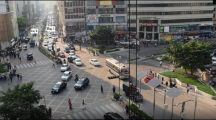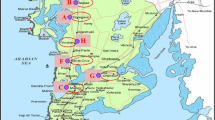Abstract
Pedestrians are considered the most vulnerable road users at intersections, and their crossing behaviors significantly impact the perception of safety. But it is very difficult to analyze pedestrian crossing behavior due to pedestrians' complex and diverse nature. Therefore, this study aimed to develop pedestrian crossing behavior and safety index models by combining qualitative and quantitative data at signalized intersections, which will help improve pedestrian movement. The data were collected and extracted from a videographic and user perception survey at four signalized intersections in Coimbatore, India. The variations in pedestrian crossing behavior concerning socio-economic variables, travel attributes, pedestrian and traffic characteristics, and geometric characteristics were identified using Pearson and Spearman correlation tests. The binary logit models were developed to evaluate pedestrian crossing behavior in noncompliance with signal, crossing in an unmarked area, and mobile usage while crossing the crosswalk. A structural equation modeling approach was adopted to combine three behaviors for analyzing crossing behavior. An ordered probit model was developed to estimate the pedestrian perception-based safety index value at signalized intersections. Finally, all the models were validated, and the statistical results showed that the proposed models predicted pedestrian crossing behavior and the safety index value more accurately under mixed traffic conditions.





Similar content being viewed by others
References
MoRTH (2020) Road Accidents in India https://doi.org/10.1016/s0386-1112(14)60239-9
Ren G, Zhou Z, Wang W, Zhang Y, Wang W (2011) Crossing behaviors of pedestrians at signalized intersections. Transp Res Rec J Transp Res Board 2264(1):65–73. https://doi.org/10.3141/2264-08
Marisamynathan S, Vedagiri P (2018) Modeling pedestrian crossing behavior and safety at signalized intersections. Transp Res Rec 2672(31):76–86. https://doi.org/10.1177/0361198118759075
Marisamynathan S, Vedagiri P (2018) Estimation of Pedestrian Safety Index Value at Signalized Intersections Under Mixed Traffic Conditions. Transp Dev Econ 4(1):1–11. https://doi.org/10.1007/s40890-018-0058-0
Marisamynathan S, Vedagiri P (2019) Pedestrian perception-based level-of-service model at signalized intersection crosswalks. J Mod Transp 27(4):266–281. https://doi.org/10.1007/s40534-019-00196-5
Albert S, Marisamynathan S (2022) Pedestrian road crossing behavior and optimal selection of pedestrian facilities at mid-block crossings. Eur Transp 87:1–16
Jiang K et al (2018) Effects of mobile phone distraction on pedestrians’ crossing behavior and visual attention allocation at a signalized intersection: an outdoor experimental study. Accid Anal Prev 115:170–177. https://doi.org/10.1016/j.aap.2018.03.019
Ulak MB, Kocatepe A, Yazici A, Ozguven EE, Kumar A (2021) A stop safety index to address pedestrian safety around bus stops. Saf Sci 133(20):105017. https://doi.org/10.1016/j.ssci.2020.105017
Asadi-Shekari Z, Moeinaddini M, Zaly Shah M (2015) Pedestrian safety index for evaluating street facilities in urban areas. Saf Sci 74:1–14. https://doi.org/10.1016/j.ssci.2014.11.014
Zegeer CV et al (2006) Index for assessing pedestrian safety at intersections. Transp Res Rec 1982:76–83. https://doi.org/10.3141/1982-11
Holland C, Hill R (2007) The effect of age, gender and driver status on pedestrians’ intentions to cross the road in risky situations. Accid Anal Prev 39(2):224–237. https://doi.org/10.1016/j.aap.2006.07.003
Ferenchak NN (2016) Pedestrian age and gender in relation to crossing behavior at midblock crossings in India. J Traffic Transp Eng English Ed 3(4):345–351. https://doi.org/10.1016/j.jtte.2015.12.001
Sisiopiku VP, Akin D (2003) Pedestrian behaviors at and perceptions towards various pedestrian facilities: An examination based on observation and survey data. Transp Res Part F Traffic Psychol Behav 6(4):249–274. https://doi.org/10.1016/j.trf.2003.06.001
Kadali BR, Vedagiri P (2015) Evaluation of pedestrian crosswalk level of service (LOS) in perspective of type of land-use. Transp Res Part A Policy Pract 73:113–124. https://doi.org/10.1016/j.tra.2015.01.009
Marisamynathan S, Lakshmi S (2018) Method to determine pedestrian level of service for sidewalks in Indian context. Transp Lett 10(5):294–301. https://doi.org/10.1080/19427867.2016.1264668
Pešić D, Antić B, Glavić D, Milenković M (2016) The effects of mobile phone use on pedestrian crossing behaviour at unsignalized intersections—models for predicting unsafe pedestrians behaviour. Saf Sci 82:1–8. https://doi.org/10.1016/j.ssci.2015.08.016
Tezcan HO, Elmorssy M, Aksoy G (2019) Pedestrian crossing behavior at midblock crosswalks. J Saf Res 71:49–57. https://doi.org/10.1016/j.jsr.2019.09.014
Bendak S, Alnaqbi AM, Alzarooni MY, Aljanaahi SM, Alsuwaidi SJ (2021) Factors affecting pedestrian behaviors at signalized crosswalks: an empirical study. J Saf Res 76:269–275. https://doi.org/10.1016/j.jsr.2020.12.019
Jain A, Gupta A, Rastogi R (2014) Pedestrian crossing behaviour analysis at intersections. Int J Traffic Transp Eng 4(1):103–116. https://doi.org/10.7708/ijtte.2014.4(1).08
Zhuang X, Wu C (2011) Pedestrians’ crossing behaviors and safety at unmarked roadway in China. Accid Anal Prev 43(6):1927–1936. https://doi.org/10.1016/j.aap.2011.05.005
Ren G, Zhou Z, Wang W, Zhang Y, Wang W (2011) Crossing behaviors of pedestrians at signalized intersections: Observational study and survey in China. Transp Res Rec 2264:65–73. https://doi.org/10.3141/2264-08
Wang Y, Shen B, Wu H, Wang C, Su Q, Chen W (2021) Modeling illegal pedestrian crossing behaviors at unmarked mid-block roadway based on extended decision field theory. Phys A Stat Mech Appl 562:125327. https://doi.org/10.1016/j.physa.2020.125327
Iryo-Asano M, Alhajyaseen WKM, Nakamura H (2015) Analysis and modeling of pedestrian crossing behavior during the pedestrian flashing green interval. IEEE Trans Intell Transp Syst 16(2):958–969. https://doi.org/10.1109/TITS.2014.2346154
Zhang C, Chen F, Wei Y (2019) Evaluation of pedestrian crossing behavior and safety at uncontrolled mid-block crosswalks with different numbers of lanes in China. Accid Anal Prev 123:263–273. https://doi.org/10.1016/j.aap.2018.12.002
Muley D, Kharbeche M, Alhajyaseen W, Al-Salem M (2017) Pedestrians’ crossing behavior at marked crosswalks on channelized right-turn lanes at intersections. Procedia Comput Sci 109(2016):233–240. https://doi.org/10.1016/j.procs.2017.05.339
Nasar J, Hecht P, Wener R (2008) Mobile telephones, distracted attention, and pedestrian safety. Accid Anal Prev 40(1):69–75. https://doi.org/10.1016/j.aap.2007.04.005
Truong LT, Thai NH, Le TV, Debnath AK (2022) Pedestrian distraction: mobile phone use and its associations with other risky crossing behaviours and conflict situations. Saf Sci 153:105816. https://doi.org/10.1016/j.ssci.2022.105816
Thompson LL, Rivara FP, Ayyagari RC, Ebel BE (2013) Impact of social and technological distraction on pedestrian crossing behaviour: an observational study. Inj Prev 19(4):232–237. https://doi.org/10.1136/injuryprev-2012-040601
Marisamynathan S (2017) Modeling pedestrian level of service at signalized intersection under mixed traffic conditions. Transp Res Rec J Transp Res Board 86(2634):86–94. https://doi.org/10.3141/2634-13
Hu M, Lu L, Yang J (2019) Exploring an estimation approach for the pedestrian level of service for metro stations based on an interaction index. Transp Lett 00(00):1–10. https://doi.org/10.1080/19427867.2019.1629061
Ni Y, Wang M, Sun J, Li K (2016) Evaluation of pedestrian safety at intersections: a theoretical framework based on pedestrian-vehicle interaction patterns. Accid Anal Prev 96:118–129. https://doi.org/10.1016/j.aap.2016.07.030
Nuñez Velasco JP et al (2021) Will pedestrians cross the road before an automated vehicle? The effect of drivers’ attentiveness and presence on pedestrians’ road crossing behavior. Transp Res Interdiscip Perspect. https://doi.org/10.1016/j.trip.2021.100466
Poó FM, Ledesma RD, Trujillo R (2018) Pedestrian crossing behavior, an observational study in the city of Ushuaia, Argentina. Traffic Inj Prev 19(3):305–310. https://doi.org/10.1080/15389588.2017.1391380
Russo BJ, James E, Aguilar CY, Smaglik EJ (2018) Pedestrian behavior at signalized intersection crosswalks: Observational study of factors associated with distracted walking, pedestrian violations, and walking speed. Transp Res Rec 2672(35):1–12. https://doi.org/10.1177/0361198118759949
Hashimoto Y, Yanlei G, Hsu LT, Shunsuke K (2015) A probabilistic model for the estimation of pedestrian crossing behavior at signalized intersections. In: IEEE conference on intelligent transportation system proceedings, ITSC, 2015-Octob, pp 1520–1526. https://doi.org/10.1109/ITSC.2015.248
Zhou ZP, Liu YS, Wang W, Zhang Y (2013) Multinomial logit model of pedestrian crossing behaviors at signalized intersections. Discret Dyn Nat Soc 2013:1–8. https://doi.org/10.1155/2013/172726
Zhang H, Zhang C, Chen F, Wei Y (2019) Effects of mobile phone use on pedestrian crossing behavior and safety at unsignalized intersections. Can J Civ Eng 46(5):381–388. https://doi.org/10.1139/cjce-2017-0649
Venkadavarahan M, Marisamynathan S (2022) Development of urban freight trip generation models concerning establishment classification process for a developing country. Int J Transp Sci Technol 11(3):603–618. https://doi.org/10.1016/j.ijtst.2021.08.001
Venkadavarahan M, Marisamynathan S (2022) Estimation of rider’s shifting intention for electric bike adoption: an integrated choice and latent variable approach. Transp Lett 14(10):1151–1161. https://doi.org/10.1080/19427867.2021.2000815
Ghomi H, Hussein M (2022) Analyzing the safety consequences of pedestrian spatial violation at mid-blocks: a Bayesian structural equation modeling approach. Transp Res Rec J Transp Res Board. https://doi.org/10.1177/03611981221097964
Zhou H, Romero SB, Qin X (2016) An extension of the theory of planned behavior to predict pedestrians’ violating crossing behavior using structural equation modeling. Accid Anal Prev 95:417–424. https://doi.org/10.1016/j.aap.2015.09.009
Ojo TK, Baffour Appiah A, Obiri-Yeboah A, Adebanji AO, Donkor P, Mock C (2022) Structural equation modeling of pedestrian behavior at footbridges in Ghana. Int J Inj Contr Saf Promot 29(4):489–499. https://doi.org/10.1080/17457300.2022.2081984
Acknowledgements
The authors thank the interviewers and the voluntary respondents for their assistance with the data collection in the survey.
Funding
No funding support received from any authority.
Author information
Authors and Affiliations
Corresponding author
Ethics declarations
Conflict of interest
On behalf of all authors, the corresponding author states that there is no conflict of interest.
Ethical approval
The required permission was obtained from the academic authority and traffic management department before the data collection process began.
Informed consent
Informed consent was obtained from the respondents before the commencement of the survey.
Appendices
Appendix 1
Questionnaire to capture pedestrian safety index at signalized intersections



Appendix 2
Data Collection Process at Lakshmi Mills crossing

Rights and permissions
Springer Nature or its licensor (e.g. a society or other partner) holds exclusive rights to this article under a publishing agreement with the author(s) or other rightsholder(s); author self-archiving of the accepted manuscript version of this article is solely governed by the terms of such publishing agreement and applicable law.
About this article
Cite this article
Krishnan, A.M., Marisamynathan, S. Development of pedestrian crossing behavior and safety index models at signalized intersections under mixed traffic conditions. Innov. Infrastruct. Solut. 8, 209 (2023). https://doi.org/10.1007/s41062-023-01183-w
Received:
Accepted:
Published:
DOI: https://doi.org/10.1007/s41062-023-01183-w




